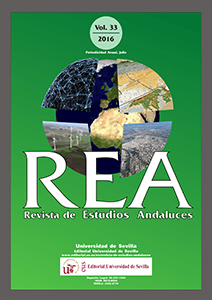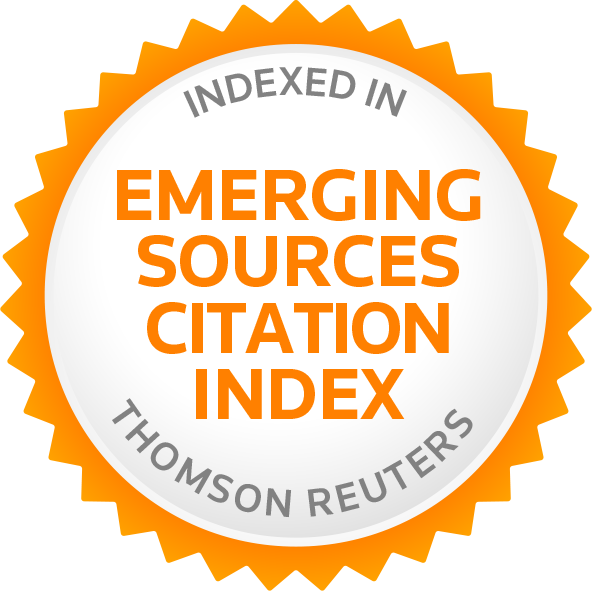Big (Geo)Data en Ciencias Sociales: Retos y Oportunidades
DOI:
https://doi.org/10.12795/rea.2016.i33.01Palabras clave:
Big Data, datos geolocalizados, redes sociales, teléfonos móviles, tarjetas inteligentesResumen
Actualmente asistimos a una verdadera revolución en la producción y el tratamiento de datos masivos (Big Data). Aunque los principales usuarios de este tipo de datos son las empresas, el mundo de la investigación ha encontrado también interesantes posibilidades en el análisis de Big Data, con abordajes nuevos a viejos problemas o incluso con el planteamiento de cuestiones que no podían ser abordadas con datos tradicionales. El presente artículo constituye una revisión de trabajos de investigación que utilizan datos masivos geolocalizados, Big (Geo)Data, y muestra ejemplos de aplicación en la investigación, ordenando los trabajos revisados según fuentes de datos: registros de llamadas de teléfonos móviles, redes sociales, comunidades de fotografías geolocalizadas, registros de transacciones con tarjetas de crédito, tarjetas inteligentes de transporte, navegadores, etc. El trabajo concluye con unas reflexiones sobre las ventajas que ofrece el Big (Geo)Data para el investigador, como la alta resolución espacial y temporal de los datos y, en muchos casos, su cobertura global y su carácter gratuito, pero también resalta algunos de los principales inconvenientes que plantea su uso, como el sesgo y la dificultad de su proceso y, en muchos casos, de acceso a los mismos.Descargas
Citas
Bagchi, M., & White, P. R. (2005): “The potential of public transport smart card data”, Transport Policy, 12(5), 464-474. http://dx.doi.org/10.1016/j.tranpol.2005.06.008
Bar-Gera, H. (2007): “Evaluation of a Cellular Phone-based System for Measurements of Traffic Speeds and Travel Times: A Case Study from Israel”, Transportation Research Part C: Emerging Technologies, 15(6): 380-391.
http://dx.doi.org/10.1016/j.trc.2007.06.003
Batty, M. (2013): “Big Data, smart cities and city planning”, Dialogues in Human Geography, 3(3), 274-279. http://dx.doi.org/10.1177/2043820613513390
Cáceres, N. (2012): “Traffic Flow Estimation Models Using Cellular Phone Data”, IEEE Transactions on Intelligent Transportation Systems, pages 1–12. http://dx.doi.org/10.1109/TITS.2012.2189006
Cáceres, N., Wideberg, J.P y Benítez, F.G. (2007): “Deriving origin–destination data from a mobile phone network”, IET Intelligent Transport Systems, 1, 15–26. http://dx.doi.org/10.1049/iet-its:20060020
Chershire, J. and Uberti, O. (2014): London: The Information Capital. 100 Maps and Graphics that Will Change How You View the City. Penguin Group. London.
Ciuccarelli, P., Lupi, G., & Simeone, L. (2014): Visualizing the Data City. (pp. 17-22). Springer International Publishing. http://dx.doi.org/10.1007/978-3-319-02195-9_3
Conover, M. D., Davis, C., Ferrara, E., McKelvey, K., Menczer, F. y Flammini, A. (2013): “The geospatial characteristics of a social movement communication network”, PloS One, 8(3), e55957. http://dx.doi.org/10.1371/journal.pone.0055957
De Choudhury, M., Feldman, M., Amer-Yahia, S., Golbandi, N., Lempel, R. y Yu, C. (2010): Automatic construction of travel itineraries using social breadcrumbs [Electronic Version], http://research.microsoft.com/en-us/um/people/munmund/pubs/ht_10_long.pdf
De Domenico, M., Lima, A. y Musolesi, M. (2013): “Interdependence and predictability of human mobility and social interactions”, Pervasive and Mobile Computing, 9(6), 798-807. http://dx.doi.org/10.1016/j.pmcj.2013.07.008
Eagle, N., Pentland, A. y Lazer, D. (2009): Inferring friendship network structure by using mobile phone data”, PNAS, 9 (36): 15274-15278. http://dx.doi.org/10.1073/pnas.0900282106
Ferreras Rodríguez, E. M. (2011): “El movimiento 15 m y su evolución en Twitter”, Telos, Cuadernos de Comunicación e Innovación, nº 89.
Frías-Martínez, V., Soto, V., Hohwald, H., y Frías-Martínez, E. (2012): “Characterizing urban landscapes using geolocated tweets”, in Privacy, Security, Risk and Trust (PASSAT), 2012 International Conference on and 2012 International Conference on Social Computing (SocialCom) (pp. 239-248). IEEE. http://dx.doi.org/10.1109/SocialCom-PASSAT.2012.19
García-Palomares, J.C., Gutiérrez, J. y Mínguez, C. (2015): “Identification of tourist hot spots based on social networks: a comparative analysis of European metropolises using photo-sharing services and GIS”, Applied Geography, 63, 408–417. http://dx.doi.org/10.1016/j.apgeog.2015.08.002
Gavric, K. D., Culibrk, D. R., Lugonja, P. I., Mirkovic, M. R. y Crnojevic, V. S. (2011): “Detecting attractive locations and tourists' dynamics using geo-referenced images”, in 2011 10th International Conference on Telecommunication in Modern Satellite Cable and Broadcasting Services (TELSIKS) (pp. 208–211), Belgrade, Oct 5–8. http://dx.doi.org/10.1109/TELSKS.2011.6112035
Graham, M., & Shelton, T. (2013): “Geography and the future of big data, big data and the future of geography”, Dialogues in Human Geography, 3(3), 255-261. http://dx.doi.org/10.1177/2043820613513121
Guttentag, D. (2013): “Airbnb: disruptive innovation and the rise of an informal tourism accommodation sector”, Current Issues in Tourism, 18, 1192-1217. http://dx.doi.org/10.1080/13683500.2013.827159
Hadas, Y. (2013): “Assessing public transport systems connectivity based on Google Transit data”, Journal of Transport Geography, 33, 105–116.h ttp://dx.doi.org/10.1016/j.jtrangeo.2013.09.015
Heerschap, N., Ortega, S., Priem, A. y Offermans, M. (2014, May): “Innovation of tourism statistics through the use of new big data sources”, in 12th Global Forum on Tourism Statistics, Prague, CZ. http://tsf2014prague.cz/assets/downloads/Paper%201.2_Nicolaes%20Heerschap_NL. pdf
Kachkaev, A. & Wood, J. (2013): “Investigating Spatial Patterns in User-Generated Photographic Datasets by Means of Interactive Visual Analytics”, Paper presented at the GeoViz Hamburg: Interactive Maps that Help People Think, 6 - 8 Mar 2013, HafenCity University, Hamburg, Germany http://openaccess.city.ac.uk/2829/1/kachkaev_geovizhamburg_2013-final.pdf
Kisilevich, S., Krstajic, M., Keim, D., Andrienko, N., & Andrienko, G. (2010): “Event- based analysis of people's activities and behavior using Flickr and Panoramio eotagged photo collections”, in 2010 14th International Conference Information Visualisation (pp. 289-296). IEEE. http://dx.doi.org/10.1109/iv.2010.94
Kitchin, R. (2013): “Big Data and human geography Opportunities, challenges and risks2, Dialogues in Human Geography, 3(3), 262-267. http://dx.doi.org/10.1177/2043820613513388
Koerbitz, W., Önder, I., y Hubmann-Haidvogel, A. C. (2013): Identifying Tourist Dispersion in Austria by Digital Footprints (pp. 495-506). Springer Berlin Heidelberg.
http://dx.doi.org/10.1007/978-3-642-36309-2_42
Krumme, C., Llorente, A., Cebrian, M., y Moro, E. (2013): “The predictability of consumer visitation patterns”, Scientific Reports, 3. http://dx.doi.org/10.1038/srep01645
Kurashima, T., Iwata, T., Irie, G. y Fujimura, K. (2013): “Travel route recommendation using geotagged photos”, Knowledge and Information Systems, 37(1), 37–60. http://link.springer.com/article/10.1007/s10115-012-0580-z http://dx.doi.org/10.1007/s10115-012-0580-z
Lenormand, M.; Picornell, M.; Cantú-Ros, O.; Tugores, A.; Louail, T.; Herranz, R.; Barthelemy, M.; Frías-Martínez, E. y Ramasco, JJ. (2014): “Cross-checking different sources of mobility information”, PLoS ONE, 9, e105184. http://dx.doi.org/10.1371/journal.pone.0105184
Lenormand, M., Louail, T., Cantú-Ros, O. G., Picornell, M., Herranz, R., Arias, J. M. y Ramasco, J. J. (2015): “Influence of sociodemographics on human mobility”, Scientific Reports, 5. http://dx.doi.org/10.1038/srep10075
Llorente, A., García-Herranz, M., Cebrián, M., & Moro, E. (2015): “Social media fingerprints of unemployment”, PloS One, 10(5), e0128692. http://dx.doi.org/10.1371/journal.pone.0128692
Louail, T.; Lenormand, M.; García Cantú, O.; Picornell, M.; Herranz, R.; Frías-Martínez, E.; Ramasco, JJ. y Barthélemy, M. (2014): “From mobile phone data to the spatial structure of cities”, Scientific Reports 4, 5276. http://dx.doi.org/10.1038/srep05276
Li, X. (2013): “Multi-day and multi-stay travel planning using geo-tagged photos”, in Proceedings of the Second ACM SIGSPATIAL International Workshop on Crowdsourced and Volunteered Geographic Information (pp. 1-8). ACM. http://dx.doi.org/10.1145/2534732.2534733
Lu, X., Wang, C., Yang, J. M., Pang, Y. y Zhang, L. (2010): “Photo2trip: generating travel routes from geo-tagged photos for trip planning”, in Proceedings of the international conference on Multimedia (pp. 143–152). ACM. http://dx.doi.org/10.1145/1873951.1873972
Mocanu, D., Baronchelli, A., Perra, N., Gonçalves, B., Zhang, Q. y Vespignani, A. (2013): “The twitter of babel: Mapping world languages through microblogging platforms”, PloS One, 8(4), e61981. http://dx.doi.org/10.1371/journal.pone.0061981
Moya-Gómez, B. and García-Palomares, J.C. (2015): “Working with the daily variation in infrastructure performance. The cases of Madrid and Barcelona”, European Transport Research Review 7(2), 20, 1-13.
Munizaga, M., Palma, C. y Mora, P. 2010: “Public transport OD matrix estimation from smart card payment system data”, in Proceedings from 12th World Conference on Transport Research, Lisbon, Paper (No. 2988).
Murthy, D. (2013): Twitter: Social communication in the Twitter age. John Wiley & Sons. Netto, V. M., Pinheiro, M., Meirelles, J. V. y Leite, H. (2015): Digital footprints in the cityscape. International Conference on Social Networks, Athens, USA.
Neutens, T., Schwanen, T., Witlox, F. y De Maeyer, P. (2010): “Evaluating the temporal organization of public service provision using space-time accessibility analysis”, Urban Geography, 31(8), 1039-1064. http://dx.doi.org/10.2747/0272-3638.31.8.1039
Nolasco-Cirugeda, A. y García Mayor, C. (2014): Aplicación de los indicadores de complejidad urbana a través de las redes sociales y TIG: El caso de los paseos marítimos de Levante y Poniente en Benidorm. Alicante, XVI Congreso Nacional de Tecnologías de la Información Geográfica, 25, 26 y 27 de Junio de 2014.
O'Connor, P. (2008). “Usergenerated content and travel: A case study on Tripadvisor. Com”, Information and Communication Technologies in Tourism, 4758.
O'Connor, P. (2010): “Managing a hotel's image on TripAdvisor”, Journal of Hospitality Marketing & Management, 19(7), 754772. http://dx.doi.org/10.1080/19368623.2010.508007 Pastor-
Escuredo, D., Morales-Guzmán, A., Torres-Fernández, Y., Bauer, J. M., Wadhwa, A., Castro-Correa, C., y Luengo-Oroz, M. (2014): “Flooding through the lens of mobile phone activity”, in Global Humanitarian Technology Conference (GHTC), 2014 IEEE (pp. 279-286). IEEE. http://dx.doi.org/10.1109/GHTC.2014.6970293
Pelletier, M. P., Trépanier, M. y Morency, C. (2011). Smart card data use in public transit: A literature review. Transportation Research Part C: Emerging Technologies, 19(4), 557-568. http://dx.doi.org/10.1016/j.trc.2010.12.003
Popescu, A., Grefenstette, G. y Moellic, P.-A. (2009): Mining Tourist Information from User-Supplied Collections. Paper presented at the Conference on Information and Knowledge Management. http://comupedia.org/adrian/articles/sp0668-popescu.pdf
http://dx.doi.org/10.1145/1645953.1646211
Ratti, C., D. Frenchman, R.M. Pulselli y S. Williams (2006): "Mobile Landscapes: using location data from cell phones for urban analysis", Environment and Planning B: Planning and Design, 33: 727-748. http://dx.doi.org/10.1068/b32047
Reades, J., F. Calabrese y C. Ratti, Eigenplaces (2009): “Analyzing Cities Using the Space-time Structure of the Mobile Phone Network”, Environment & Planning B, 36, 824-836. http://dx.doi.org/10.1068/b34133t
Sakaki, T., Okazaki, M. y Matsuo, Y. (2010): “Earthquake shakes Twitter users: real-time event detection by social sensors”, in Proceedings of the 19th international conference on World Wide Web (pp. 851-860). ACM. http://dx.doi.org/10.1145/1772690.1772777
Segerberg, A. y Bennett, W. L. (2011): “Social media and the organization of collective action: Using Twitter to explore the ecologies of two climate change protests”, The Communication Review, 14(3), 197215. http://dx.doi.org/10.1080/10714421.2011.597250
Shelton, T., Poorthuis, A., & Zook, M. (2015): “Social media and the city: Rethinking urban socio-spatial inequality using user-generated geographic information”, Landscape and Urban Planning, 142, 198-211. http://dx.doi.org/10.1016/j.landurbplan.2015.02.020
Serrano-Estrada, L., Serrano Salazara, S. y Álvarez Álvarez. F.J. (2014): Las redes sociales y los SIG como herramientas para conocer las preferencias sociales en las ciudades turísticas: el caso de Benidorm. Alicante, XVI Congreso Nacional de Tecnologías de la Información Geográfica, 25, 26 y 27 de Junio de 2014.
Sobolevsky S, Sitko I, Grauwin S, Des Combes RT, Hawelka B, et al. (2014a): “Mining Urban Performance: Scale-Independent Classification of Cities based on Individual Economic Transactions”, in: Big Data Science and Computing, 2014 ASE International Conference on, May 27–31, Stanford University. p. 10.
Sobolevsky S, Sitko I, Tachet des Combes R, Hawelka B, Murillo Arias J, et al. (2014b): “Money on the Move: Big Data of Bank Card Transactions as the New Proxy for Human Mobility Patterns and Regional Delineation. The Case of Residents and Foreign Visitors in Spain2, in: Big Data (BigData Congress), 2014 IEEE International Congress on, Jun 27-Jul 2, Anchorage, AK. pp.136–143. doi:10.1109/BigData.Congress.2014.28. http://dx.doi.org/10.1109/BigData.Congress.2014.28
Sobolevsky S, Bojic I, Belyi A, Sitko I, Hawelka B, et al. (2015a): “Scaling of city attractiveness for foreign visitors through big data of human economical and social media activity”, arXiv:150406003.
Sobolevsky, S., Sitko, I., Combes, R. T. D., Hawelka, B., Arias, J. M., & Ratti, C. (2015b): “Cities through the Prism of People's Spending Behavior”, arXiv preprint arXiv:1505.03854.
Straumann, R. K., Çöltekin, A., & Andrienko, G. (2014): “Towards (Re) Constructing Narratives from Georeferenced Photographs through Visual Analytics”, The Cartographic Journal, 51(2), 152–165. http://dx.doi.org/10.1179/1743277414Y.0000000079
Sun, Y., & Fan, H. (2014): “Event Identification from Georeferenced Images”, in Connecting a Digital Europe through Location and Place. (pp. 73-88). Springer International Publishing. http://dx.doi.org/10.1007/978-3-319-03611-3_5
Takhteyev, Y., Gruzd, A., & Wellman, B. (2012): “Geography of Twitter networks”, Social Networks, 34(1), 73-81. http://dx.doi.org/10.1016/j.socnet.2011.05.006
Tao, S., Rohde, D., & Corcoran, J. (2014): “Examining the spatial–temporal dynamics of bus passenger travel behaviour using smart card data and the flow-comap”, Journal of Transport Geography, 41, 21-36. http://dx.doi.org/10.1016/j.jtrangeo.2014.08.006
Wu, L., Zhi, Y., Sui, Z., & Liu, Y. (2014): “Intra-urban human mobility and activity transition: evidence from social media check-in data”, PloS One, 9(5), e97010. http://dx.doi.org/10.1371/journal.pone.0097010
Zielstra, D., & Hochmair, H. H. (2011): “Comparative Study of Pedestrian Accessibility to Transit Stations Using Free and Proprietary Network Data”, Transportation Research Record: Journal of the Transportation Research Board, 2217(1), 145-152. http://dx.doi.org/10.3141/2217-18
Zhai, S., Xu, X., Yang, L., Zhou, M., Zhang, L. y Qiu, B. (2015): “Mapping the popularity of urban restaurants using social media data”, Applied Geography, 63, 113-120. http://dx.doi.org/10.1016/j.apgeog.2015.06.006
Descargas
Publicado
Cómo citar
Número
Sección
Licencia
La edición electrónica de la Revista de Estudios Andaluces se ofrece en acceso abierto desde el número 28 publicado en 2011 hasta la actualidad. Las ediciones impresa y electrónica de esta Revista son editadas por la Editorial de la Universidad de Sevilla, siendo necesario citar la procedencia en cualquier reproducción parcial o total.
La Revista de Estudios Andaluces no cobra tasas por el envío de trabajos, ni tampoco cuotas por la publicación de sus artículos. La Revista es gratuita desde el momento de la publicación de cada número y sus contenidos se distribuyen con la licencia “CreativeCommons Atribución-NoComercial-SinDerivar 4.0 Internacional” , que permite al usuario de la Revista de Estudios Andaluces criterios que cumplen con la definición de open access de la Declaración de Budapest en favor del acceso abierto. Puede consultar desde aquí la versión informativa y el texto legal de la licencia. Esta circunstancia ha de hacerse constar expresamente de esta forma cuando sea necesario.
Aceptado 2016-04-22
Publicado 2016-07-25







